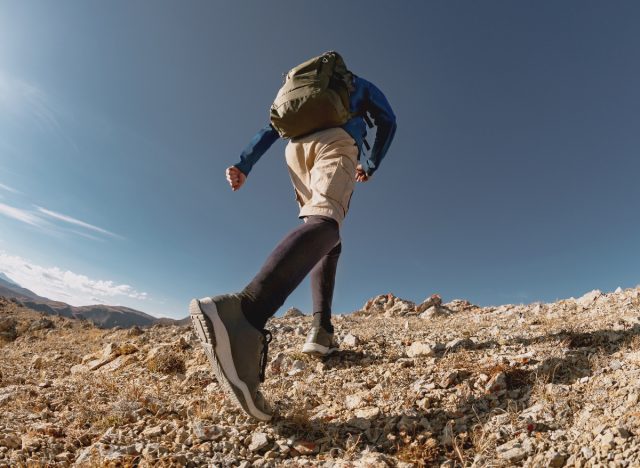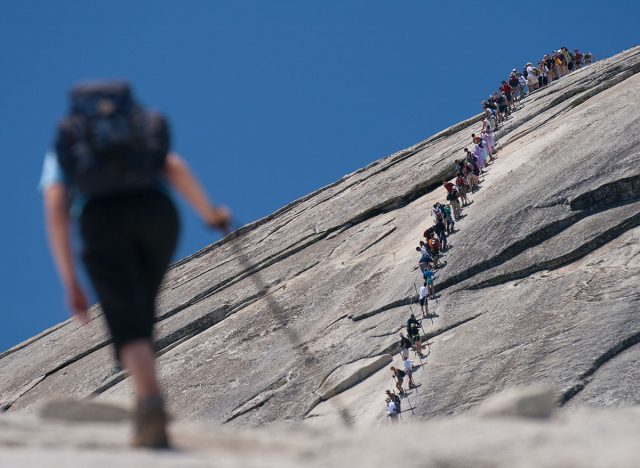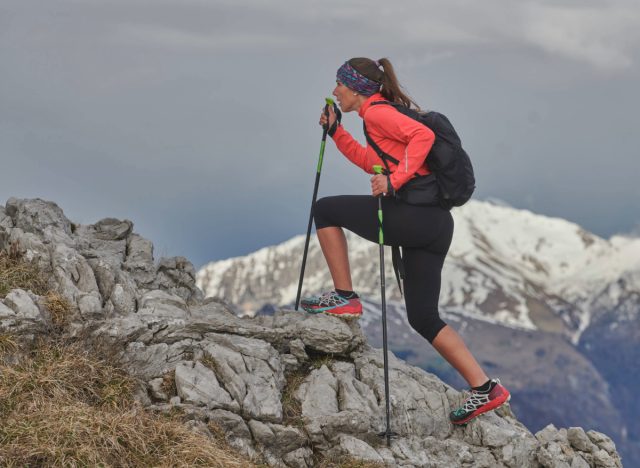6 Soft Hiking Tricks That Build More Strength Than Gym Workouts After 45

Few things feel more invigorating than lacing up your hiking boots and exploring a new trail. From the sun-drenched days of summer to crisp autumn afternoons, hiking connects you with nature while feeding the mind, body, and soul. The newest trend to hit the trails? “Soft hiking,” which is all about keeping things light and intentional. We spoke with experts to learn six soft hiking techniques that actually build more strength than gym workouts after 45.
What Is Soft Hiking?
Soft hiking emphasizes moving with purpose at a comfortable pace. You’re still challenging your body while weaving through uneven terrain and engaging your muscles without excessive load.
“It uses less intense and slower therapeutic movements, balance, and resistance to natural bodyweight instead of high-impact movements,” says Shahinaz Soliman, MD, board-certified family physician with 20+ years of experience in patient care. “This modality is appropriate in people over 45 because it encourages building strength at a long-term, low-risk level that honors joint health and recovery requirements.”
6 Soft Hiking Techniques That Build More Strength Than Gym Workouts
Include inclines.

Inclines introduce a fresh challenge to your hike. Choose easy upward slopes while keeping your step-ups slow and steady.
“This is a natural increase of glutes, hamstrings, and calves without the use of heavy weights,” says Soliman.
Don’t shy away from natural obstacles.

Navigating objects like rocks and logs is another way to instantly boost the effectiveness of your hike.
“The introduction of natural obstacles promotes the use of stabilizer muscles that are not given serious attention in gym machines,” Soliman says.
Actively engage your arms.

Don’t forget about working your arms!
“Trekking poles or recreating arm movements will use upper body muscles and enhance overall coordination and calorie expenditure,” Soliman points out.
Balaram Thapa, CEO of Nepal Hiking Team, notes to position the poles so that your elbows are near 90 degrees, and “plant-pull” with every step. Complete six sets of two-minute efforts on rolling ground, activating your core.
Descend slowly.

When going downhill, descend slowly.
“Slow, controlled [descent] is one of the most effective methods to strengthen quadriceps and enhance balance, compared to walking normally,” Soliman notes.
Do bodyweight exercises.

Weave some bodyweight exercises into your hike. The key is pausing and holding the movement.
“Pause in lunge or half-squat poses a few times on the way to activate the core and leg muscles in the isometric mode with minimum load on the joints,” Soliman instructs.
Perform hill repeats.

Thapa recommends hill repeats: climbing for three to four minutes, descending gradually, and repeating for four to six rounds in total.
“Keep steps short, drive through the mid-foot, and breathe rhythmically,” Thapa says.
What Makes These Techniques More Effective Than Gym Workouts.
According to Soliman, “Soft hiking combines various muscle groups dynamically and functionally in a natural setting, which puts greater pressure on the body as compared to isolated gym work. Balance, a controlled movement, and weight-bearing activities in uneven terrain encourage the neuromuscular coordination and stability of the joints.”
Thapa says soft hiking loads various planes of movement. “[In addition, it] builds eccentric control, and [challenges] balance. You strengthen feet, ankles, knees, and hips together while protecting joints with self-selected pace and terrain.”
Outdoor exercise promotes longer workout sessions and sustainability. In adults 45+, this equals safer strength gains and far less boredom that’s often associated with standard gym routines.
Looking for easy ways to lose fat? Here’s How Long Your Walking Workout Should Be To Shrink Belly Fat.